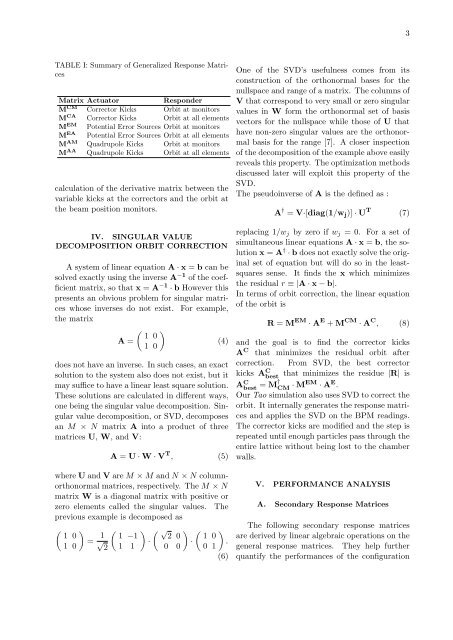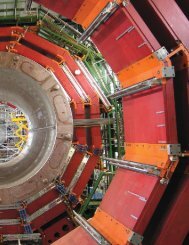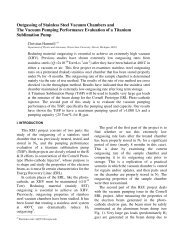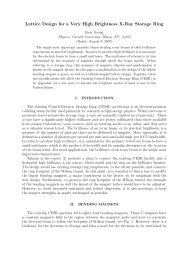Analysis and Optimization of Singular Value Decomposition Orbit ...
Analysis and Optimization of Singular Value Decomposition Orbit ...
Analysis and Optimization of Singular Value Decomposition Orbit ...
Create successful ePaper yourself
Turn your PDF publications into a flip-book with our unique Google optimized e-Paper software.
3<br />
TABLE I: Summary <strong>of</strong> Generalized Response Matrices<br />
Matrix Actuator<br />
Responder<br />
M CM Corrector Kicks <strong>Orbit</strong> at monitors<br />
M CA Corrector Kicks <strong>Orbit</strong> at all elements<br />
M EM Potential Error Sources <strong>Orbit</strong> at monitors<br />
M EA Potential Error Sources <strong>Orbit</strong> at all elements<br />
M AM Quadrupole Kicks <strong>Orbit</strong> at monitors<br />
M AA Quadrupole Kicks <strong>Orbit</strong> at all elements<br />
calculation <strong>of</strong> the derivative matrix between the<br />
variable kicks at the correctors <strong>and</strong> the orbit at<br />
the beam position monitors.<br />
IV. SINGULAR VALUE<br />
DECOMPOSITION ORBIT CORRECTION<br />
A system <strong>of</strong> linear equation A · x = b can be<br />
solved exactly using the inverse A −1 <strong>of</strong> the coefficient<br />
matrix, so that x = A −1 · b However this<br />
presents an obvious problem for singular matrices<br />
whose inverses do not exist. For example,<br />
the matrix<br />
( ) 1 0<br />
A =<br />
(4)<br />
1 0<br />
does not have an inverse. In such cases, an exact<br />
solution to the system also does not exist, but it<br />
may suffice to have a linear least square solution.<br />
These solutions are calculated in different ways,<br />
one being the singular value decomposition. <strong>Singular</strong><br />
value decomposition, or SVD, decomposes<br />
an M × N matrix A into a product <strong>of</strong> three<br />
matrices U, W, <strong>and</strong> V:<br />
A = U · W · V T , (5)<br />
where U <strong>and</strong> V are M × M <strong>and</strong> N × N columnorthonormal<br />
matrices, respectively. The M × N<br />
matrix W is a diagonal matrix with positive or<br />
zero elements called the singular values. The<br />
previous example is decomposed as<br />
( ) 1 0<br />
= 1 ( ) ( √ ) ( )<br />
1 −1 2 0 1 0<br />
√ · · .<br />
1 0 2 1 1 0 0 0 1<br />
(6)<br />
One <strong>of</strong> the SVD’s usefulness comes from its<br />
construction <strong>of</strong> the orthonormal bases for the<br />
nullspace <strong>and</strong> range <strong>of</strong> a matrix. The columns <strong>of</strong><br />
V that correspond to very small or zero singular<br />
values in W form the orthonormal set <strong>of</strong> basis<br />
vectors for the nullspace while those <strong>of</strong> U that<br />
have non-zero singular values are the orthonormal<br />
basis for the range [7]. A closer inspection<br />
<strong>of</strong> the decomposition <strong>of</strong> the example above easily<br />
reveals this property. The optimization methods<br />
discussed later will exploit this property <strong>of</strong> the<br />
SVD.<br />
The pseudoinverse <strong>of</strong> A is the defined as :<br />
A † = V·[diag(1/w j )] · U T (7)<br />
replacing 1/w j by zero if w j = 0. For a set <strong>of</strong><br />
simultaneous linear equations A · x = b, the solution<br />
x = A † · b does not exactly solve the original<br />
set <strong>of</strong> equation but will do so in the leastsquares<br />
sense. It finds the x which minimizes<br />
the residual r ≡ |A · x − b|.<br />
In terms <strong>of</strong> orbit correction, the linear equation<br />
<strong>of</strong> the orbit is<br />
R = M EM · A E + M CM · A C , (8)<br />
<strong>and</strong> the goal is to find the corrector kicks<br />
A C that minimizes the residual orbit after<br />
correction. From SVD, the best corrector<br />
kicks A C best<br />
that minimizes the residue |R| is<br />
A C best = M† CM · MEM · A E .<br />
Our Tao simulation also uses SVD to correct the<br />
orbit. It internally generates the response matrices<br />
<strong>and</strong> applies the SVD on the BPM readings.<br />
The corrector kicks are modified <strong>and</strong> the step is<br />
repeated until enough particles pass through the<br />
entire lattice without being lost to the chamber<br />
walls.<br />
V. PERFORMANCE ANALYSIS<br />
A. Secondary Response Matrices<br />
The following secondary response matrices<br />
are derived by linear algebraic operations on the<br />
general response matrices. They help further<br />
quantify the performances <strong>of</strong> the configuration









